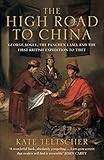承前*1
Madeleine Bunting*2 “Akong Rinpoche was key to Tibetan Buddhism flourishing in the west” http://www.theguardian.com/commentisfree/belief/2013/oct/14/akong-rinpoche-tibetan-buddhism-west
先日中国四川省成都でトラブルに巻き込まれ、殺されたチベット仏教の活仏 Akong Rinpoche師の追悼記事。
現代西洋社会への佛教の流布を全て西蔵仏教に帰してしまうと、(例えば)創価学会系の人々からの反論は免れ得ないだろう。しかし、チベット仏教が大きな役割を果たしていることは否定できない。中国共産党政権の西蔵制圧の予期せざる効果としての西蔵仏教のグローバル化。
Buddhism's popularity over the past half-century in the west has surprised and dismayed in almost equal measure. Alongside the fad for Buddhist statues in garden centres, there has been a much more serious engagement with hundreds of centres opening, many of the most dynamic founded by Tibetan Buddhists. Given that Tibet had limited contact with modernity until the 20th century, it's been an extraordinary story of cultural export. The vivid colour and spectacle of Tibetan Buddhist monasteries, and the warmth and humour of their teachers, have contributed to making Buddhism into a rare religious success in a deepening secularism. Tibetan Buddhist teachers have familiarised thousands with meditation, increasing interest from academic researchers into the benefits of mindfulness.
Akong Rinpoche師の生い立ち、印度を経て英国に定住し、スコットランドに「桑耶寺(Kagyu Samyé Ling Monastery and Tibetan Centre)」*3を開くまで;
この文章の中で、2人の(英国人)仏教関係者が言及されている。一人目はKen Holmes*5。教師で、Akong Rinpoche師とは40年以上共同で活動している。二人目はJohn Peacock*6。元チベット仏教僧の仏教学者で、現在はチベット仏教自体から距離を取っている。
(…) As a small child he was taken from his nomadic family to a monastery as an important reincarnation. Throughout his childhood he was honoured as a great teacher. At the age of 19, as the Chinese arrived in Tibet and destroyed thousands of monasteries, he set off on foot for India, a journey of indescribable suffering in which hundreds of fellow refugees died of starvation, exhaustion and attacks. Four years later in 1963 he arrived in England and worked as a hospital orderly in Oxford supporting a fellow Tibetan monk who was studying. Within a few years, he had gone from a life of immense monastic prestige to scrubbing toilets in a foreign country.Anyone visiting Samye Ling, the monastery Akong Rinpoche co-founded in the Scottish Borders in 1963*4, or the London centre (now in a magnificent former library in Bermondsey) cannot fail to be impressed by the sheer scale of the ambition they represent. This kind of institution-building by a refugee community and the volunteer effort it has inspired are hard to match. The temples are lavishly decorated with paintings and statues according to Tibetan practice, and the rituals and ceremonies are an extraordinary spectacle of drums, bells and chanting by Tibetan monks, as well as dozens of western counterparts – an experience of Tibet in the rainy hills of the Scottish Borders.
ところで、スコットランドとチベットとは18世紀に遡っての因縁があったのだった(Cf. Kate Teltscher The High Road to China*7)。

The High Road to China: George Bogle, the Panchen Lama and the First British Expedition to Tibet
- 作者: Kate Teltscher
- 出版社/メーカー: Bloomsbury Publishing PLC
- 発売日: 2007/08/06
- メディア: ペーパーバック
- クリック: 1回
- この商品を含むブログ (5件) を見る
*1:http://d.hatena.ne.jp/sumita-m/20131010/1381373150
*2:See also http://d.hatena.ne.jp/sumita-m/20050831 http://d.hatena.ne.jp/sumita-m/20091101/1257084108
*3:http://www.samyeling.org/ See also http://en.wikipedia.org/wiki/Kagyu_Samy%C3%A9_Ling_Monastery_and_Tibetan_Centre
*4:1967年の誤りか。
*6:See eg. http://oxfordmindfulness.org/question/about-john-peacock/ http://secularbuddhism.org/2012/05/04/what-is-this-path-of-mindfulness-john-peacock-talk/
*7:Mentioned in http://d.hatena.ne.jp/sumita-m/20130223/1361640990